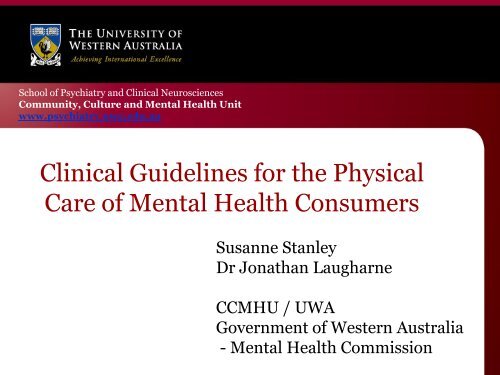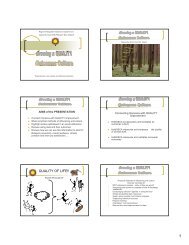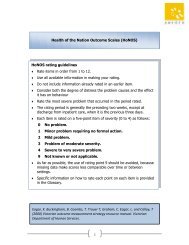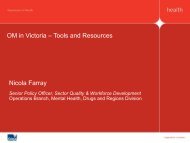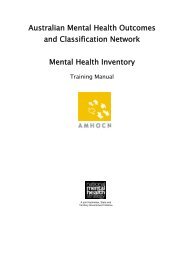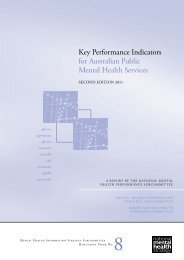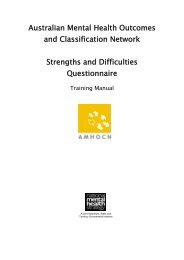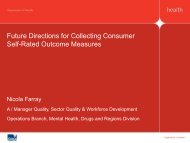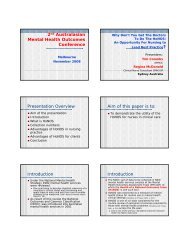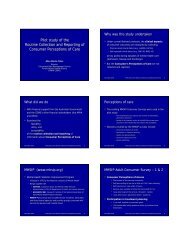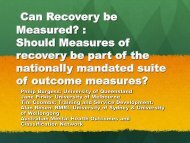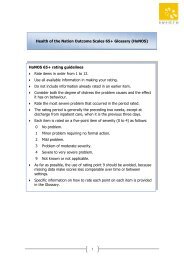Clinical Guidelines for the Physical Care of Mental Health Consumers
Clinical Guidelines for the Physical Care of Mental Health Consumers
Clinical Guidelines for the Physical Care of Mental Health Consumers
Create successful ePaper yourself
Turn your PDF publications into a flip-book with our unique Google optimized e-Paper software.
School <strong>of</strong> Psychiatry and <strong>Clinical</strong> Neurosciences<br />
Community, Culture and <strong>Mental</strong> <strong>Health</strong> Unit<br />
www.psychiatry.uwa.edu.au<br />
<strong>Clinical</strong> <strong>Guidelines</strong> <strong>for</strong> <strong>the</strong> <strong>Physical</strong><br />
<strong>Care</strong> <strong>of</strong> <strong>Mental</strong> <strong>Health</strong> <strong>Consumers</strong><br />
Susanne Stanley<br />
Dr Jonathan Laugharne<br />
CCMHU / UWA<br />
Government <strong>of</strong> Western Australia<br />
- <strong>Mental</strong> <strong>Health</strong> Commission
Overview<br />
‣ Background to <strong>the</strong> project<br />
‣ Dimensions <strong>of</strong> <strong>Physical</strong> <strong>Health</strong> <strong>for</strong><br />
mental health consumers<br />
‣ Outline <strong>of</strong> each component in <strong>the</strong><br />
package<br />
Community, Culture and <strong>Mental</strong><br />
<strong>Health</strong> Unit<br />
2
Duty to <strong>Care</strong> Report (Lawrence, Holman & Jablensky,<br />
2001)<br />
• People with a mental illness have considerably elevated<br />
mortality rates from all main causes <strong>of</strong> death. Overall<br />
mortality rate is 2.5 times higher than <strong>the</strong> general population.<br />
• Greatest number <strong>of</strong> excess deaths in mentally ill due to<br />
ischaemic heart disease.<br />
• High rates <strong>of</strong> hepatitis, HIV, alcohol-related and smokingrelated<br />
disorders, deficiency anaemias<br />
• Poor cancer prognoses<br />
• Low rates <strong>of</strong> revascularisation procedure, high risk <strong>of</strong><br />
surgical complications<br />
Community, Culture and <strong>Mental</strong><br />
<strong>Health</strong> Unit<br />
3
• Who is Your GP report (<strong>Health</strong>Right Advisory Group, WA<br />
Office <strong>of</strong> <strong>Mental</strong> <strong>Health</strong>, 2004)<br />
– Raise awareness, educate health pr<strong>of</strong>essionals, and include<br />
physical health care in <strong>the</strong> routine care <strong>of</strong> mental health<br />
patients and provide proper documentation<br />
– Recognise <strong>the</strong> central role <strong>of</strong> GPs<br />
– Enhance <strong>the</strong> voice <strong>of</strong> patients, <strong>the</strong>ir families and carers<br />
– Develop targeted health promotion and illness prevention<br />
strategies<br />
– Better coordination and integration <strong>of</strong> physical and mental<br />
health care<br />
– Fur<strong>the</strong>r research, and ongoing monitoring and evaluation<br />
• Department <strong>of</strong> <strong>Health</strong>, <strong>Mental</strong> <strong>Health</strong> Division, WA 2009<br />
– Review national/international literature and develop<br />
<strong>Clinical</strong> <strong>Guidelines</strong><br />
Community, Culture and <strong>Mental</strong><br />
<strong>Health</strong> Unit<br />
4
<strong>Clinical</strong> <strong>Guidelines</strong> <strong>for</strong> <strong>the</strong> <strong>Physical</strong> <strong>Care</strong> <strong>of</strong><br />
<strong>Mental</strong> <strong>Health</strong> <strong>Consumers</strong><br />
• Comprehensive literature review:<br />
– Identified 5 dimensions <strong>of</strong> physical health <strong>for</strong> mental<br />
health consumers<br />
• Medication<br />
• <strong>Physical</strong> Disorders<br />
• Lifestyle<br />
• Alcohol & Illicit Drug Use<br />
• Psychosocial Supports<br />
• Identify practical, evidence-based clinical screening tools and<br />
protocols<br />
• Develop an individualised assessment and monitoring package<br />
<strong>for</strong> clinical use<br />
Community, Culture and <strong>Mental</strong><br />
<strong>Health</strong> Unit<br />
5
Dimensions <strong>of</strong> <strong>Physical</strong> <strong>Health</strong><br />
6
<strong>Clinical</strong> <strong>Guidelines</strong> <strong>for</strong> <strong>the</strong> <strong>Physical</strong> <strong>Care</strong> <strong>of</strong><br />
<strong>Mental</strong> <strong>Health</strong> <strong>Consumers</strong> Package<br />
Five Components:<br />
(1) Report<br />
(2) Wall Chart - Metabolic Syndrome Algorithm<br />
(3) Clinician Handbook<br />
(4) Psychosocial Assessment booklet<br />
(5) Screening Forms<br />
Community, Culture and <strong>Mental</strong><br />
<strong>Health</strong> Unit<br />
7
Metabolic syndrome<br />
• Cluster <strong>of</strong> inter-related risk factors <strong>for</strong> <strong>the</strong><br />
development <strong>of</strong> cardiovascular disease and type 2<br />
diabetes<br />
• 2-3 fold increased risk <strong>of</strong> MI or CVA, 5 fold<br />
increased risk <strong>of</strong> type 2 diabetes<br />
• Affects 19-29% <strong>of</strong> Australians over 25 yrs <strong>of</strong> age<br />
Zimmett et al, 2005<br />
• Syndrome <strong>of</strong> considerable public health significance
Metabolic syndrome criteria<br />
• World <strong>Health</strong> Organization<br />
• American Heart Association<br />
• International Diabetes Federation (2005) –<br />
consensus definition “easy to use in clinical practice<br />
….a simple diagnostic and clinical tool….ease<br />
comparison <strong>of</strong> data”
Metabolic syndrome and mental illness<br />
• Prevalence <strong>of</strong> Met S in psychiatric patients 24-53% (US & Europe<br />
data)<br />
• CATIE : 36% men (cf 20%) & 52% women (cf 25%)<br />
• Western Australia: 54% prevalence <strong>of</strong> Met S in all patients on<br />
antipsychotics, more prevalent in bipolar patients than schizophrenia.<br />
John et al 2009<br />
• NSW: rehab cohort (all with psychosis) Met S 68%, overweight 29%,<br />
obesity 59% Tirupati & Chua 2007
Wall Chart Algorithm - Metabolic Syndrome<br />
12
Handbook<br />
• In<strong>for</strong>mative, evidence-based booklet <strong>for</strong> clinicians<br />
• Outlines recommended investigations and adverse effects<br />
<strong>for</strong> all <strong>of</strong> <strong>the</strong> major medication categories<br />
– Antidepressants<br />
– Anxiolytics<br />
– Antipsychotics & Mood Stabilisers<br />
– Carbamazepine<br />
– Lithium Carbonate<br />
– Valproic Acid<br />
– Clozapine<br />
• Provides normative ranges <strong>for</strong> tests<br />
• Summary <strong>of</strong> core health in<strong>for</strong>mation<br />
Community, Culture and <strong>Mental</strong><br />
<strong>Health</strong> Unit<br />
13
• Highlights common physical conditions (Pre-existing or<br />
developing)<br />
– HIV/AIDS & STD‟s<br />
– Hepatitis B&C<br />
– Cancer<br />
– Irritable Bowel & Gastrointestinal disorders<br />
– Type 2 Diabetes<br />
– Cardiovascular Disease<br />
– Respiratory Disease<br />
• Outlines research data and assessment issues <strong>for</strong> major<br />
dimensions <strong>of</strong> physical health <strong>for</strong> mental health<br />
consumers<br />
Community, Culture and <strong>Mental</strong><br />
<strong>Health</strong> Unit<br />
14
Psychosocial Assessment Booklet<br />
Culture / Religion / Spirituality survey:<br />
Cultural Safety = Collaboration (Williams, 1998)<br />
Shared respect, meaning, knowledge, experience, listening<br />
• Language / need <strong>for</strong> interpreter<br />
• Autonomy versus Relatedness:<br />
- Importance to <strong>the</strong> person<br />
- Current perceptions<br />
• Impact <strong>of</strong> culture/religion/spirituality on <strong>the</strong> person‟s life<br />
• Person‟s understanding <strong>of</strong> physical and mental health, problems,<br />
treatment<br />
Community, Culture and <strong>Mental</strong><br />
<strong>Health</strong> Unit<br />
15
Exercise and Diet:<br />
• <strong>Physical</strong> activity levels (Lifescripts - Department <strong>of</strong><br />
<strong>Health</strong> & Ageing, 2008)<br />
• Weight and Body Mass Index (BMI) (WHO, 2004)<br />
• Abdominal Girth (Waterreus & Laugharne, 2009)<br />
• Nutrition and Diet (referral based on BMI & abdominal<br />
girth)<br />
Smoking:<br />
• Probability <strong>of</strong> dependence<br />
• Interest in quitting – need <strong>for</strong> in<strong>for</strong>mation<br />
• Confidence in quitting – need <strong>for</strong> support<br />
(Lifescripts - Department <strong>of</strong> <strong>Health</strong> & Ageing, 2008)<br />
Community, Culture and <strong>Mental</strong><br />
<strong>Health</strong> Unit<br />
16
Oral/Dental:<br />
• Natural teeth and dentures<br />
• Problems e.g. pain, difficulty eating etc.<br />
• Oral side-effects <strong>of</strong> medication<br />
• Dental treatment<br />
- Registered with a dentist<br />
- Last saw a dentist<br />
Adapted from Griffiths et al. (2000) - “Oral healthcare <strong>for</strong> people<br />
with mental health problems: <strong>Guidelines</strong> and recommendations”<br />
Sexual Activity:<br />
• Sexual behaviour<br />
• Sexual difficulties – medication effects<br />
• Contraception<br />
• HIV/AIDS and Sexually Transmitted Infection‟s (STI‟s)<br />
Community, Culture and <strong>Mental</strong><br />
<strong>Health</strong> Unit<br />
17
Alcohol:<br />
• AUDIT – Alcohol Use Disorder Identification Test (Babor,<br />
de la Fuente, Saunders & Grant, 1992)<br />
• SADQ-C – Severity <strong>of</strong> Alcohol Dependence Questionnaire<br />
(Stockwell, Sitharan, McGrath & Lang, 1994)<br />
O<strong>the</strong>r Drugs:<br />
• DAST – Drug Abuse Screening Test (Skinner, 1982)<br />
• SDS – Severity <strong>of</strong> Dependence Scales (Gossop et al., 1995)<br />
* All tests found to be reliable with psychiatric populations<br />
Community, Culture and <strong>Mental</strong><br />
<strong>Health</strong> Unit<br />
18
Psychosocial Supports Survey:<br />
• Based on <strong>the</strong> MOS Social Support Survey (Sherbourne & Stewart,<br />
1991), and Jacobson‟s (1986) „types and timing‟ <strong>of</strong> social supports<br />
“Social relationships influence <strong>the</strong> health outcomes <strong>of</strong> adults”<br />
(Holt-Lunstad, Smith & Layton, 2010, p.14)<br />
Community, Culture and <strong>Mental</strong><br />
<strong>Health</strong> Unit<br />
19
Screening Forms<br />
20
Summary<br />
• The <strong>Clinical</strong> <strong>Guidelines</strong> <strong>for</strong> <strong>the</strong> <strong>Physical</strong> <strong>Care</strong> <strong>of</strong><br />
<strong>Mental</strong> <strong>Health</strong> <strong>Consumers</strong> package is:<br />
– Consumer-focused<br />
– Developed <strong>for</strong> clinicians<br />
– Encourages a partnership approach, need to develop<br />
Consumer Handbook to assist consumers to care <strong>for</strong><br />
and monitor <strong>the</strong>mselves<br />
– Provides an overall, individualised, evidence-based<br />
evaluation <strong>of</strong> each consumer‟s physical health status<br />
– Incorporates ongoing monitoring<br />
Community, Culture and <strong>Mental</strong><br />
<strong>Health</strong> Unit<br />
23
Fur<strong>the</strong>r in<strong>for</strong>mation:<br />
jonathan.laugharne@uwa.edu.au


